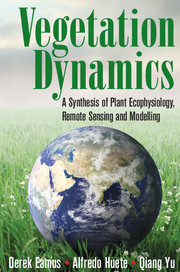Book contents
- Frontmatter
- Contents
- Preface
- Section One Plant Ecophysiology
- Section Two Remote Sensing
- Section Three Modelling
- 8 An Introduction to Modelling in Plant Ecophysiology
- 9 Modelling Radiation Exchange and Energy Balances of Leaves and Canopies
- 10 Modelling Leaf and Canopy Photosynthesis
- 11 Modelling Stomatal and Canopy Conductance
- 12 Modelling Leaf and Canopy Transpiration and the Soil-Plant-Atmosphere Continuum
- 13 Coupling Models of Photosynthesis, Transpiration and Stomatal Conductance and Environmental Controls of Leaf Function
- Section Four Case Studies
- Index
- References
8 - An Introduction to Modelling in Plant Ecophysiology
from Section Three - Modelling
Published online by Cambridge University Press: 05 June 2016
- Frontmatter
- Contents
- Preface
- Section One Plant Ecophysiology
- Section Two Remote Sensing
- Section Three Modelling
- 8 An Introduction to Modelling in Plant Ecophysiology
- 9 Modelling Radiation Exchange and Energy Balances of Leaves and Canopies
- 10 Modelling Leaf and Canopy Photosynthesis
- 11 Modelling Stomatal and Canopy Conductance
- 12 Modelling Leaf and Canopy Transpiration and the Soil-Plant-Atmosphere Continuum
- 13 Coupling Models of Photosynthesis, Transpiration and Stomatal Conductance and Environmental Controls of Leaf Function
- Section Four Case Studies
- Index
- References
Summary
Introduction
Knowledge of the exchange of water, carbon and energy above plant canopies provides a fundamental basis for understanding climate-vegetation interactions, land surface processes, carbon sequestration accounting, water-use-efficiency and water management. In this chapter, plant-environment interactions are discussed through insight of biophysical and biological processes (Chapters 2 and 3) within the soil-plant-atmosphere continuum (SPAC).
Theoretically, water and energy transfer in the SPAC provides the physical basis for understanding plant growth in relation to environmental variation, while plant physiological regulation is the biological basis for plant growth and environmental feedbacks. For example, increased diffuse radiation arising from cloud cover can increase canopy light-use-efficiency. Similarly increased atmospheric CO2 concentration can lift photosynthetic rates and decrease transpiration. Changes in rates of carbon uptake and transpiration alter canopy water-use-efficiency (WUE), while decreased latent heat flux alters the radiation balance, reducing atmospheric and increasing leaf temperature. Soil water stress limits crop water-use, decreases rates of photosynthesis and alters canopy energy balances and crop yield. It is clear that these processes have significant interactions, including feedback and feed-forward loops. How to include the biophysical feedbacks and interactions is the subject matter of subsequent modelling chapters (Chapters 9–13).
Canopy Photosynthesis and Water Flow through the SPAC
Processes and Up-Scaling in Modelling
Biophysical and physiological processes within the SPAC can be divided into three components: (1) radiation exchange and energy balance; (2) hydrological architecture and water transfer; and (3) photosynthesis and physiological regulation of carbon gain. Vegetation responds to variation in environmental factors (e.g. light, rainfall, temperature, VPD) through changes in rates of photosynthesis and transpiration. Feedbacks between canopies and local environmental factors determine canopy microclimate. The microclimate of vegetation is the growth environment in which plants exist at the local scale and which control radiation, heat, and water exchanges (Rosenberg et al. 1983). In the interaction of plant-and-environment, physical processes form the basis for change in microclimate, which vary at small-to-medium spatial and temporal scales.
Physiological responses to a changing environment have been intensively studied in the past three decades, from sub-cellular- and leaf-scales through to regional and global scales. Simulation models of physiological processes and their response to variation in environmental factors are the basis of the study of interactions between plant and environment, including the effects of global warming and elevated atmospheric CO2 concentrations on vegetation.
- Type
- Chapter
- Information
- Vegetation DynamicsA Synthesis of Plant Ecophysiology, Remote Sensing and Modelling, pp. 239 - 243Publisher: Cambridge University PressPrint publication year: 2016



